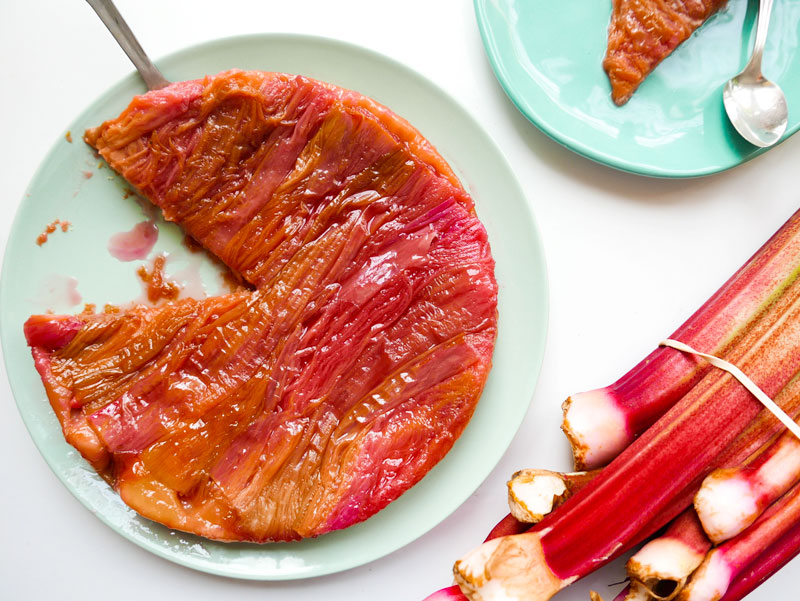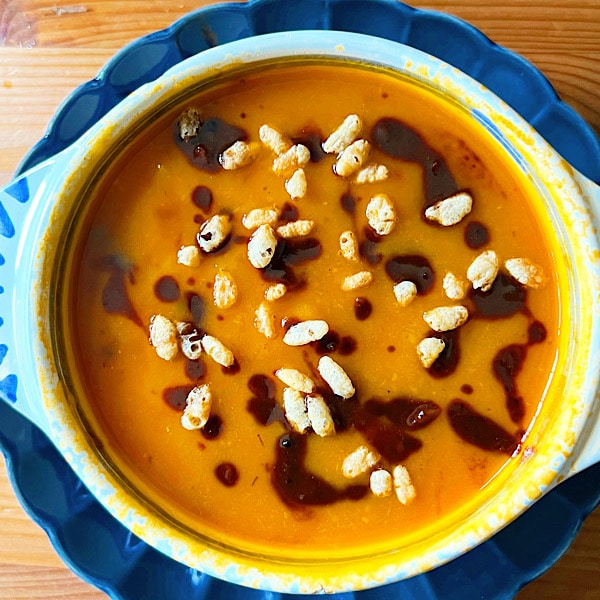Take two classic French tarte recipes and what do you get? This rhubarb tarte tatin, which is so very easy… and effortlessly beautiful.
The French are BIG rhubarb fans. They preserve it in jams, stew it into compotes, and, of course, make lots of rhubarb tarts in the summer. France also has an incredible range of rhubarb-flavored prepared foods that includes yogurt, juice (note to self: come up with a cocktail that calls for rhubarb juice), tea and energy bars.
The French also love their tarte tatins—sweet, glistening upside-down tarts are made by baking the topping (traditionally apples) on a bed of caramel with the crust placed on top.
And now, I’m hoping the French (i.e., my French friends) will love my rhubarb tarte tatinas much as I do. I adore how the upside-down alchemy of the tarte tatin technique softens the rhubarb into a veil of juicy, sour-sweet, melt-in-your-mouth goodness. It may look a little different than a typical tarte à la rhubarbe (most French recipes call for the rhubarb to be cut into shorter pieces) it still tastes like pure French pastry tradition.
I wish the rhubarb I’d used for the photo below (the first tarte I tried) had been rosier, but the local rhubarb I can get tends more towards green and I’d rather settle for so-so color than so-so flavor.
If you don’t feel like making a homemade crust, any prepared dough will do (I’m partial to puff pastry). And if you want to make the dessert vegan, simply omit the egg yolk.
CRUST
1 ¼ cups (160 g.) all-purpose flour
1/3 cup (80 g.) cold butter, cut into small pieces
1 tsp. sugar
pinch of salt
1 egg yolk
cold water
RHUBARB TATIN
¾ cup (150 g.) pure cane/caster sugar
¼ cup (50 ml.) water
1 lb. rhubarb stalks (weighed without the leaves)
TO MAKE THE CRUST: Place the flour, butter, sugar, and salt in the bowl of a food processor, and pulse until the mixture resembles coarse meal. Place the egg yolk in a cup measure, and add the elderflower liqueur, if using. Top off with enough very cold water to have 1/3 cup (80 ml.) liquid. Add the liquid to the flour mixture, and pulse in the food processor just until a dough forms. Shape the dough into a round disk, wrap in plastic wrap, and chill 1 hour, or overnight.
TO MAKE THE RHUBARB TATIN: Combine the sugar and water in a small saucepan and bring to a rolling boil, stirring once or twice to dissolve the sugar. Boil 5 to 7 minutes, or until the sugar syrup just begins to turn a pale brown (caramelize). Pour and swirl the light caramel over the bottom of a 9- or 10-inch (23-25 cm) round cake pan or ovenproof skillet.
CUT the rhubarb stalks into lengths that will fit snugly into the cake pan, halving larger stalks if necessary so they are all the same width. Place the stalks on top of the caramel, squeezing in as many as you can.
PREHEAT the oven to 400˚F.
ROLL OUT the Crust dough to a 10-inch circle. Place the dough over the rhubarb and press the edges of the crust tightly against the sides of the pan, folding the excess dough over to make a thin lip. Use a fork to crimp the lip so that it lies close against the sides. Pierce the center of the crust with a knife to let the steam out as the tart cooks.
BAKE the tart 20 to 25 minutes, or until the crust is golden brown. Cool 30 minutes.
PLACE the serving plate on top of the cake pan, and unmold the tart, using a small spatula or knife to loosen any rhubarb that remains stuck to the pan. (If the tart is cold and won’t unmold, reheat it in a 200-degree oven for 15 minutes to melt the caramel and loosen it.)
SERVE tart slices warm or cold.
Note: If making the rhubarb tarte tatin ahead, reheat it and unmold it just before serving so that the crust doesn’t get soggy.
Serves 8




That looks so easy and beautiful!!! Did you have any trouble with stringiness?
None at all…but the rhubarb I get is pretty young. It all just melts away and cuts so easily…